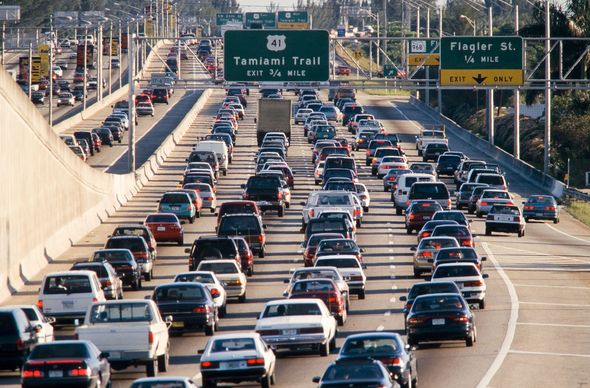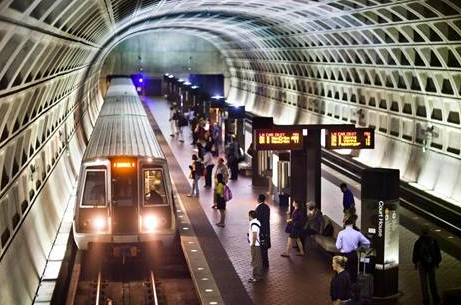Congestion Puts Nearly One-Half Million High Skilled Jobs at Risk in Growth Regions
 According to a new report, heavy congestion in key growth regions across North America is putting nearly one-half million high-skilled jobs at risk.
According to a new report, heavy congestion in key growth regions across North America is putting nearly one-half million high-skilled jobs at risk.
These finding, issued by the American Public Transportation Association, clearly notes that public transit is one viable solution to help battle congestion that threatens American’s competitive advantage. The findings note that companies located in the nation’s most productive regions need additional public transportation to reach their full employment potential.
The report, The Role of Transit in Support of High Growth Business Clusters in the U.S. , conducted by the Economic Development Research Corporation and commissioned by APTA, projects that 480,000 new jobs representing $32 billion per year in income will be at risk due to congestion by 2040. The study was released at a U.S. Capitol Hill briefing sponsored by the Congressional Public Transportation Caucus.
“These industries in high-growth areas rely on creative, high-skilled workers who choose places where public transportation is an option,” said U.S. Representative Michael Grimm (R-NY) and co-chair of the Public Transportation Caucus. “With physical limitations to adding highway lanes, public transportation is the most cost-effective option to help support sustained job growth in these locations.”
“Only with robust, reliable and safe public transportation systems can we begin to unlock the country’s true economic potential,” said U.S. Representative Dan Lipinski (D-IL). “As our economy continues to evolve in the 21st century, it is imperative that we provide employers and workers with more options to connect people to jobs. Improving public transportation is a critical part of meeting this goal.”
 APTA President and CEO Michael Melaniphy stated, “Public transportation provides the access to enable high-tech and high-growth industries to cluster in areas that can attract the talent they need, while avoiding the consequences of constrained growth. Public transportation investment is a key ingredient in helping these firms enhance their productivity and compete on a global stage.”
APTA President and CEO Michael Melaniphy stated, “Public transportation provides the access to enable high-tech and high-growth industries to cluster in areas that can attract the talent they need, while avoiding the consequences of constrained growth. Public transportation investment is a key ingredient in helping these firms enhance their productivity and compete on a global stage.”
Glen Weisbrod, President of the Economic Development Research Corporation, and author of the report noted that the American economy is driven by technology-oriented and high-growth business sectors that rely on clustering in urban locations, where these businesses can best access R&D centers, information sharing and a large, skilled workforce.
The study examines the key high-growth and high-tech business clusters in the United States and analyzes the impact transportation access constraints have on eight areas. They are: “Medline” area in Atlanta, GA; Kendall Square in Boston, MA; Route 128 Technology Cluster in Burlington, MA; Mid-Town and South of Market, San Francisco, CA; Silicon Valley, CA; Deerfield, IL; Technology Center, Denver, CO; and South Lake Union, Seattle, WA.
“Silicon Valley’s economy is fueled by the productivity of a world-class, knowledge-based workforce,” said Silicon Valley Leadership Group CEO Carl Guardino. “That workforce is less productive, more constrained and less successful when trapped in traffic, when our time could be used more productively while riding transit. It is why the Leadership Group has led several successful sales tax campaigns to fund transit options of all types for our talented workers and their families.”
According to the report, there is a fundamental change in the U.S. economy. In the future, a disproportionate number of American jobs will be in knowledge-based industries that are most successful when they locate near one another. As a result, these firms have specific location requirements and increasingly depend upon a workforce that wants a number of mobility options. Therefore, to optimize employment opportunity, public transportation investment will be a necessary ingredient.
The American Public Transportation Association (APTA) is a nonprofit international association of 1,500 public and private sector organizations, engaged in the areas of bus, paratransit, light rail, commuter rail, subways, waterborne services, and intercity and high-speed passenger rail. This includes: transit systems; planning, design, construction, and finance firms; product and service providers; academic institutions; transit associations and state departments of transportation. APTA is the only association in North America that represents all modes of public transportation. APTA members serve the public interest by providing safe, efficient and economical transit services and products. More than 90 percent of the people using public transportation in the United States and Canada ride APTA member systems.
Category: General Update









